Factors Influencing Student Laptop Purchase Decisions: Dissertation
VerifiedAdded on 2019/12/28
|64
|17234
|45
Dissertation
AI Summary
This dissertation investigates the purchase decisions of students regarding laptops, focusing on students enrolled at Chester University. The research aims to assess consumer behavior, understand students' perceptions and opinions on laptop selection, identify factors influencing their buying decisions, and suggest ways to improve student buying behavior. The study employs a deductive approach with a positivism philosophy and a descriptive design, utilizing both primary and secondary data collection methods from a sample of 30 students. Key areas of focus include the influence of consumer behavior, personal preferences, and external factors such as price, product design, and marketing strategies. The dissertation includes a literature review, research methodology, findings, and analysis, culminating in conclusions and recommendations for future research. The research methodology incorporates a deductive research approach with positivism research philosophy, and uses a qualitative research type employing both primary and secondary data collection. The findings are presented using thematic analysis, and the study concludes with recommendations for future studies in the domain of student laptop purchase decisions.
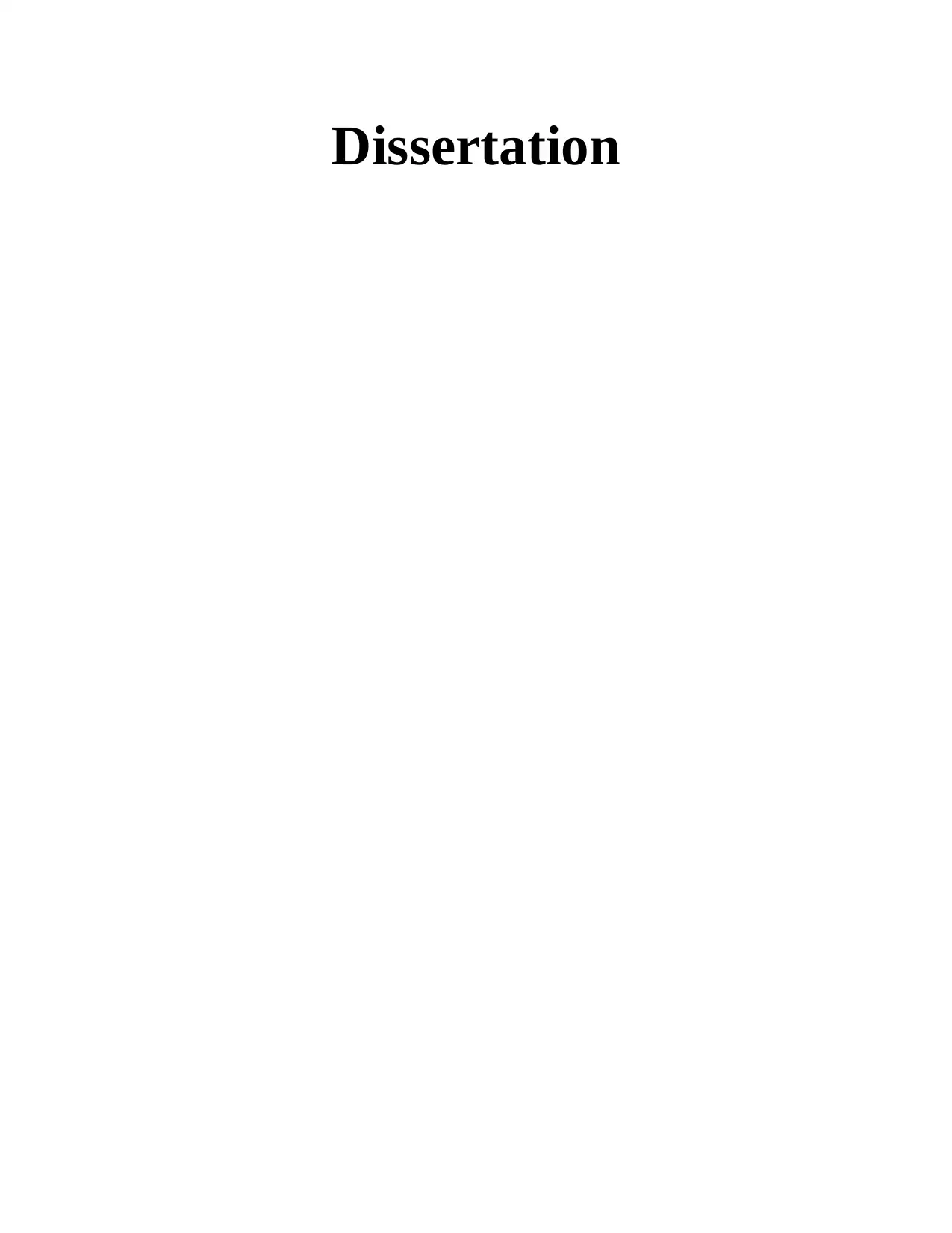
Dissertation
Paraphrase This Document
Need a fresh take? Get an instant paraphrase of this document with our AI Paraphraser
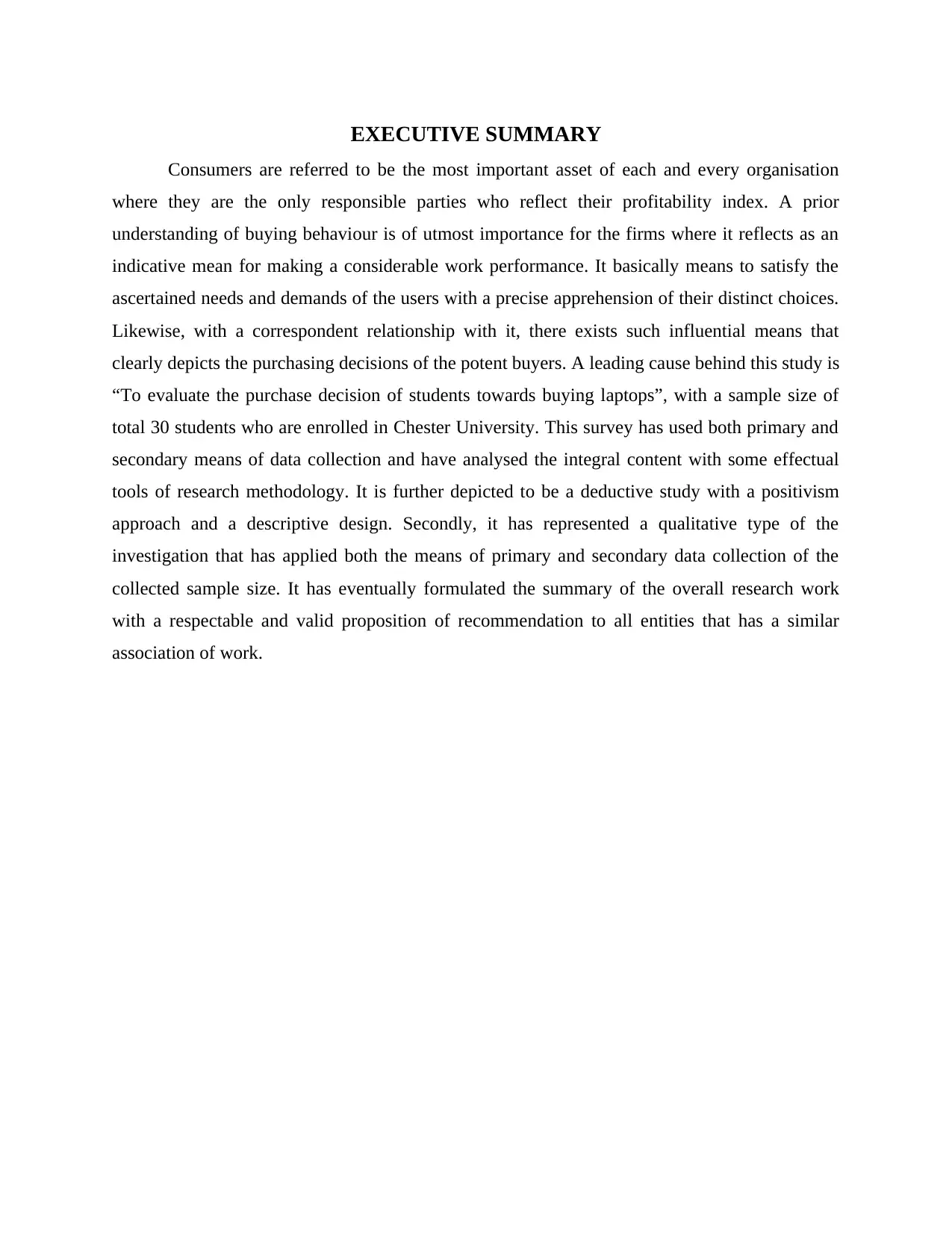
EXECUTIVE SUMMARY
Consumers are referred to be the most important asset of each and every organisation
where they are the only responsible parties who reflect their profitability index. A prior
understanding of buying behaviour is of utmost importance for the firms where it reflects as an
indicative mean for making a considerable work performance. It basically means to satisfy the
ascertained needs and demands of the users with a precise apprehension of their distinct choices.
Likewise, with a correspondent relationship with it, there exists such influential means that
clearly depicts the purchasing decisions of the potent buyers. A leading cause behind this study is
“To evaluate the purchase decision of students towards buying laptops”, with a sample size of
total 30 students who are enrolled in Chester University. This survey has used both primary and
secondary means of data collection and have analysed the integral content with some effectual
tools of research methodology. It is further depicted to be a deductive study with a positivism
approach and a descriptive design. Secondly, it has represented a qualitative type of the
investigation that has applied both the means of primary and secondary data collection of the
collected sample size. It has eventually formulated the summary of the overall research work
with a respectable and valid proposition of recommendation to all entities that has a similar
association of work.
Consumers are referred to be the most important asset of each and every organisation
where they are the only responsible parties who reflect their profitability index. A prior
understanding of buying behaviour is of utmost importance for the firms where it reflects as an
indicative mean for making a considerable work performance. It basically means to satisfy the
ascertained needs and demands of the users with a precise apprehension of their distinct choices.
Likewise, with a correspondent relationship with it, there exists such influential means that
clearly depicts the purchasing decisions of the potent buyers. A leading cause behind this study is
“To evaluate the purchase decision of students towards buying laptops”, with a sample size of
total 30 students who are enrolled in Chester University. This survey has used both primary and
secondary means of data collection and have analysed the integral content with some effectual
tools of research methodology. It is further depicted to be a deductive study with a positivism
approach and a descriptive design. Secondly, it has represented a qualitative type of the
investigation that has applied both the means of primary and secondary data collection of the
collected sample size. It has eventually formulated the summary of the overall research work
with a respectable and valid proposition of recommendation to all entities that has a similar
association of work.
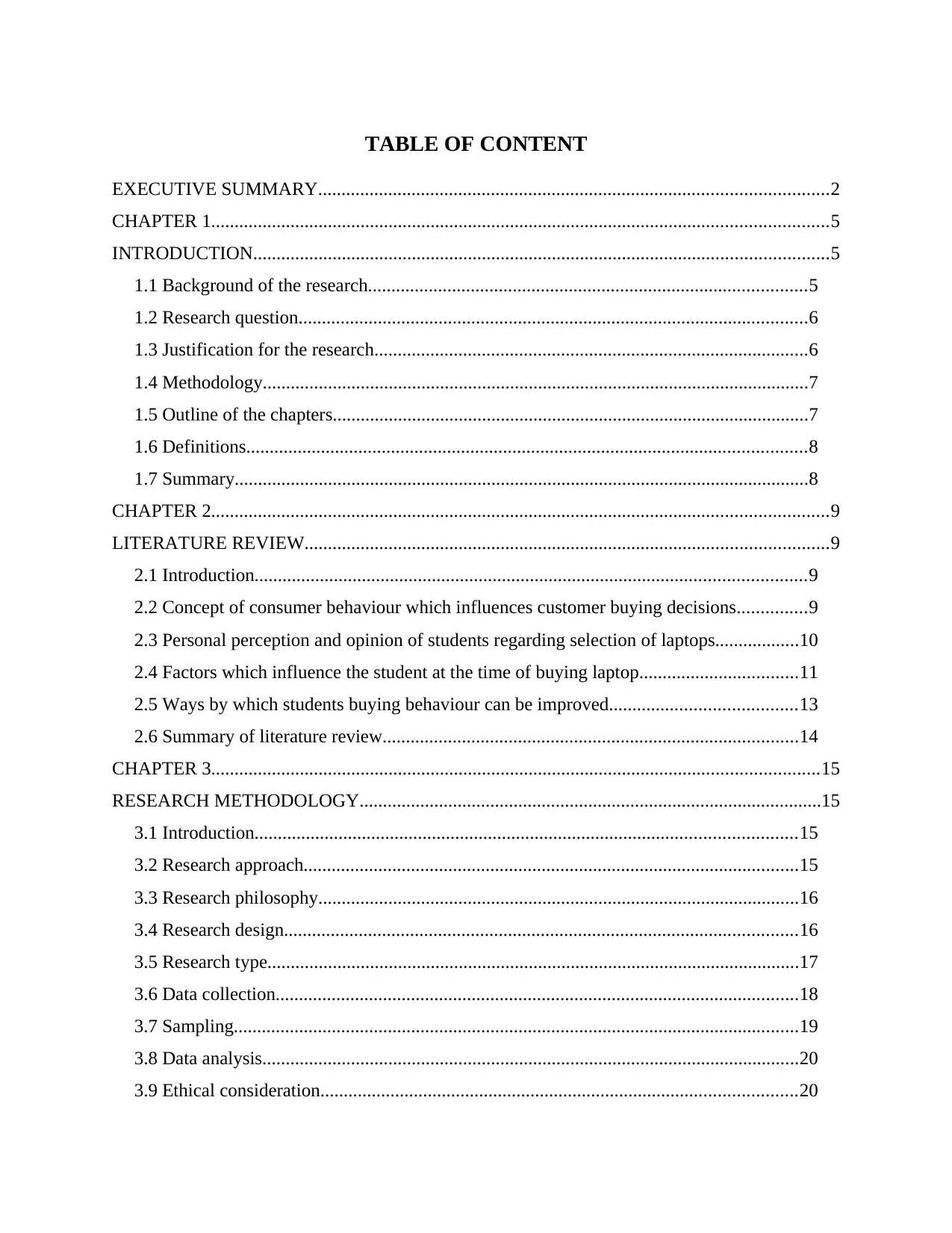
TABLE OF CONTENT
EXECUTIVE SUMMARY.............................................................................................................2
CHAPTER 1....................................................................................................................................5
INTRODUCTION...........................................................................................................................5
1.1 Background of the research..............................................................................................5
1.2 Research question.............................................................................................................6
1.3 Justification for the research.............................................................................................6
1.4 Methodology.....................................................................................................................7
1.5 Outline of the chapters......................................................................................................7
1.6 Definitions........................................................................................................................8
1.7 Summary...........................................................................................................................8
CHAPTER 2....................................................................................................................................9
LITERATURE REVIEW................................................................................................................9
2.1 Introduction......................................................................................................................9
2.2 Concept of consumer behaviour which influences customer buying decisions...............9
2.3 Personal perception and opinion of students regarding selection of laptops..................10
2.4 Factors which influence the student at the time of buying laptop..................................11
2.5 Ways by which students buying behaviour can be improved........................................13
2.6 Summary of literature review.........................................................................................14
CHAPTER 3..................................................................................................................................15
RESEARCH METHODOLOGY...................................................................................................15
3.1 Introduction....................................................................................................................15
3.2 Research approach..........................................................................................................15
3.3 Research philosophy.......................................................................................................16
3.4 Research design..............................................................................................................16
3.5 Research type..................................................................................................................17
3.6 Data collection................................................................................................................18
3.7 Sampling.........................................................................................................................19
3.8 Data analysis...................................................................................................................20
3.9 Ethical consideration......................................................................................................20
EXECUTIVE SUMMARY.............................................................................................................2
CHAPTER 1....................................................................................................................................5
INTRODUCTION...........................................................................................................................5
1.1 Background of the research..............................................................................................5
1.2 Research question.............................................................................................................6
1.3 Justification for the research.............................................................................................6
1.4 Methodology.....................................................................................................................7
1.5 Outline of the chapters......................................................................................................7
1.6 Definitions........................................................................................................................8
1.7 Summary...........................................................................................................................8
CHAPTER 2....................................................................................................................................9
LITERATURE REVIEW................................................................................................................9
2.1 Introduction......................................................................................................................9
2.2 Concept of consumer behaviour which influences customer buying decisions...............9
2.3 Personal perception and opinion of students regarding selection of laptops..................10
2.4 Factors which influence the student at the time of buying laptop..................................11
2.5 Ways by which students buying behaviour can be improved........................................13
2.6 Summary of literature review.........................................................................................14
CHAPTER 3..................................................................................................................................15
RESEARCH METHODOLOGY...................................................................................................15
3.1 Introduction....................................................................................................................15
3.2 Research approach..........................................................................................................15
3.3 Research philosophy.......................................................................................................16
3.4 Research design..............................................................................................................16
3.5 Research type..................................................................................................................17
3.6 Data collection................................................................................................................18
3.7 Sampling.........................................................................................................................19
3.8 Data analysis...................................................................................................................20
3.9 Ethical consideration......................................................................................................20
⊘ This is a preview!⊘
Do you want full access?
Subscribe today to unlock all pages.

Trusted by 1+ million students worldwide

3.10 Research limitations.....................................................................................................21
3.11 Reliability and validity.................................................................................................22
3.12 Summary.......................................................................................................................22
CHAPTER 4: FINDINGS.............................................................................................................24
4.1 Introduction....................................................................................................................24
4.2 Thematic analysis...........................................................................................................24
CHAPTER 5: ANALYSIS AND CONCLUSION........................................................................49
5.1 Introduction....................................................................................................................49
5.2 Conclusion......................................................................................................................49
5.3 Recommendations..........................................................................................................50
REFERENCES..............................................................................................................................52
APPENDIX 1: Questionnaire........................................................................................................55
APPENDIX 2: PERSONAL INTERVIEW...................................................................................59
APPENDIX 3: STATISTICS........................................................................................................60
3.11 Reliability and validity.................................................................................................22
3.12 Summary.......................................................................................................................22
CHAPTER 4: FINDINGS.............................................................................................................24
4.1 Introduction....................................................................................................................24
4.2 Thematic analysis...........................................................................................................24
CHAPTER 5: ANALYSIS AND CONCLUSION........................................................................49
5.1 Introduction....................................................................................................................49
5.2 Conclusion......................................................................................................................49
5.3 Recommendations..........................................................................................................50
REFERENCES..............................................................................................................................52
APPENDIX 1: Questionnaire........................................................................................................55
APPENDIX 2: PERSONAL INTERVIEW...................................................................................59
APPENDIX 3: STATISTICS........................................................................................................60
Paraphrase This Document
Need a fresh take? Get an instant paraphrase of this document with our AI Paraphraser
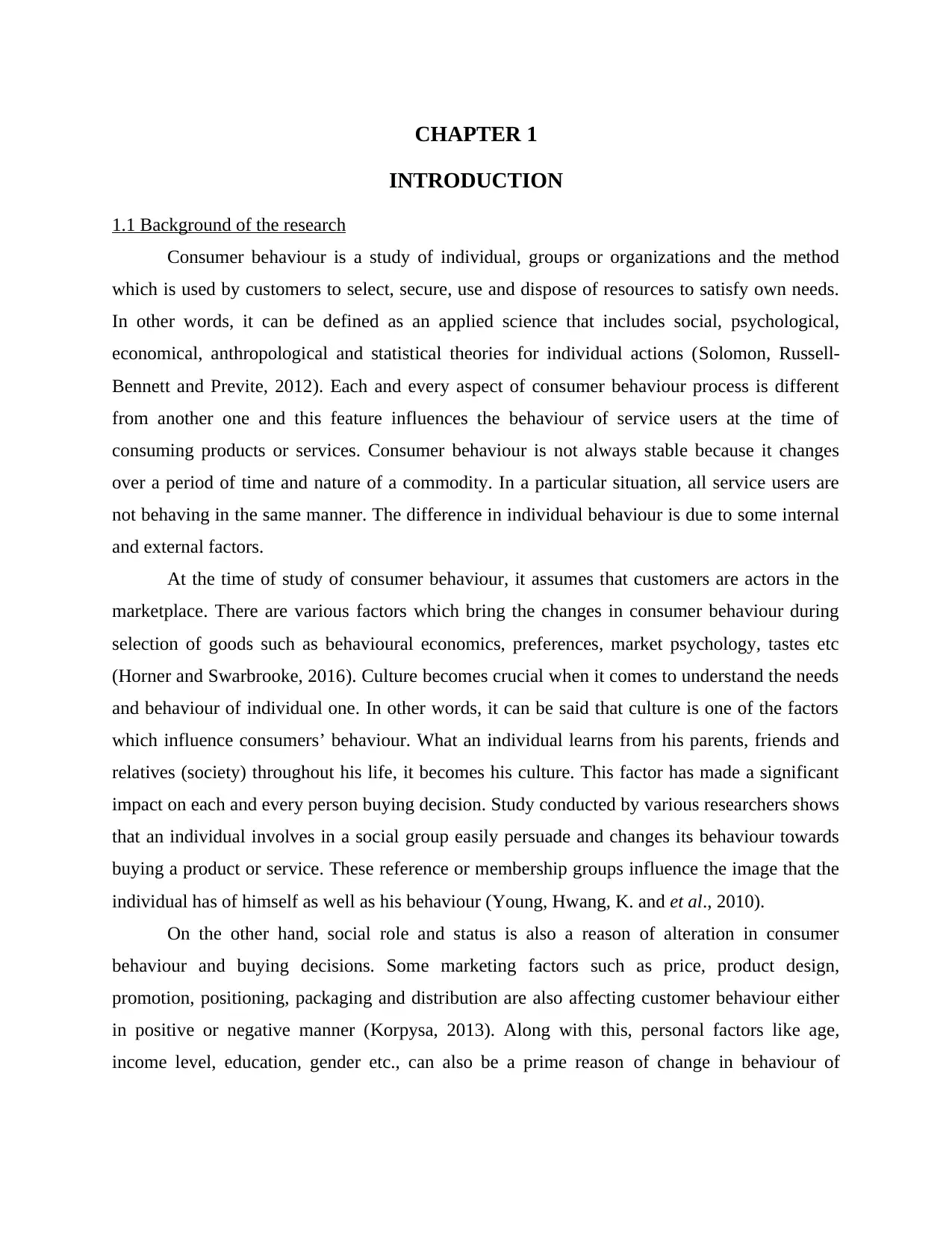
CHAPTER 1
INTRODUCTION
1.1 Background of the research
Consumer behaviour is a study of individual, groups or organizations and the method
which is used by customers to select, secure, use and dispose of resources to satisfy own needs.
In other words, it can be defined as an applied science that includes social, psychological,
economical, anthropological and statistical theories for individual actions (Solomon, Russell-
Bennett and Previte, 2012). Each and every aspect of consumer behaviour process is different
from another one and this feature influences the behaviour of service users at the time of
consuming products or services. Consumer behaviour is not always stable because it changes
over a period of time and nature of a commodity. In a particular situation, all service users are
not behaving in the same manner. The difference in individual behaviour is due to some internal
and external factors.
At the time of study of consumer behaviour, it assumes that customers are actors in the
marketplace. There are various factors which bring the changes in consumer behaviour during
selection of goods such as behavioural economics, preferences, market psychology, tastes etc
(Horner and Swarbrooke, 2016). Culture becomes crucial when it comes to understand the needs
and behaviour of individual one. In other words, it can be said that culture is one of the factors
which influence consumers’ behaviour. What an individual learns from his parents, friends and
relatives (society) throughout his life, it becomes his culture. This factor has made a significant
impact on each and every person buying decision. Study conducted by various researchers shows
that an individual involves in a social group easily persuade and changes its behaviour towards
buying a product or service. These reference or membership groups influence the image that the
individual has of himself as well as his behaviour (Young, Hwang, K. and et al., 2010).
On the other hand, social role and status is also a reason of alteration in consumer
behaviour and buying decisions. Some marketing factors such as price, product design,
promotion, positioning, packaging and distribution are also affecting customer behaviour either
in positive or negative manner (Korpysa, 2013). Along with this, personal factors like age,
income level, education, gender etc., can also be a prime reason of change in behaviour of
INTRODUCTION
1.1 Background of the research
Consumer behaviour is a study of individual, groups or organizations and the method
which is used by customers to select, secure, use and dispose of resources to satisfy own needs.
In other words, it can be defined as an applied science that includes social, psychological,
economical, anthropological and statistical theories for individual actions (Solomon, Russell-
Bennett and Previte, 2012). Each and every aspect of consumer behaviour process is different
from another one and this feature influences the behaviour of service users at the time of
consuming products or services. Consumer behaviour is not always stable because it changes
over a period of time and nature of a commodity. In a particular situation, all service users are
not behaving in the same manner. The difference in individual behaviour is due to some internal
and external factors.
At the time of study of consumer behaviour, it assumes that customers are actors in the
marketplace. There are various factors which bring the changes in consumer behaviour during
selection of goods such as behavioural economics, preferences, market psychology, tastes etc
(Horner and Swarbrooke, 2016). Culture becomes crucial when it comes to understand the needs
and behaviour of individual one. In other words, it can be said that culture is one of the factors
which influence consumers’ behaviour. What an individual learns from his parents, friends and
relatives (society) throughout his life, it becomes his culture. This factor has made a significant
impact on each and every person buying decision. Study conducted by various researchers shows
that an individual involves in a social group easily persuade and changes its behaviour towards
buying a product or service. These reference or membership groups influence the image that the
individual has of himself as well as his behaviour (Young, Hwang, K. and et al., 2010).
On the other hand, social role and status is also a reason of alteration in consumer
behaviour and buying decisions. Some marketing factors such as price, product design,
promotion, positioning, packaging and distribution are also affecting customer behaviour either
in positive or negative manner (Korpysa, 2013). Along with this, personal factors like age,
income level, education, gender etc., can also be a prime reason of change in behaviour of

individual in the context of making a decision to purchase a service or a product (Solomon,
2014).
1.2 Research question
Aims
To assess the students purchase decision towards buying laptops: A case of Chester University.
Research objectives
To evaluate the concept of consumer behaviour which influence customer buying decisions.
To understood personal perception and opinion of students regarding selection of laptops.
To determine those factors which influence the student at the time of buying laptop. To suggest the ways by which students buying behaviour can be improved.
Research questions
1. What is the meaning of consumer behaviour which impacts on customer buying
decisions?
2. What are the personal perception and opinion of students at the time of selection of
laptops?
3. What are those factors that influence students during buying laptop?
4. What are the ways by which students buying behaviour towards laptop can be enhanced?
1.3 Justification for the research
From the point of view of customers, they are in a tough spot. They are living totally in
highly developed and technologically advanced society. Consumer buying behaviour is linked to
one of the imperative influence among the consumers to services or products which are offered
by a company (Schiffman & et.al., 2013). On the basis of this, an organization set up some
strategies to make variation in consumer buying behaviour. The present dissertation is conducted
on assessing the students purchase decision towards buying laptops. In the present time, laptops
are just like a mobile computers and today in the world of technology, students are using these
objects to gain more and more knowledge from various sources. Using laptops for various
purposes give learners hands on experience to learn become technology savvy. As a student,
laptop facilitates numerous advantages in many aspects. There are different factors which
influence the learner purchase decision towards buying laptops (Gössling, Scott and et al., 2012).
So, with the help of this, the researcher wants to assess buying behaviour of students regarding
2014).
1.2 Research question
Aims
To assess the students purchase decision towards buying laptops: A case of Chester University.
Research objectives
To evaluate the concept of consumer behaviour which influence customer buying decisions.
To understood personal perception and opinion of students regarding selection of laptops.
To determine those factors which influence the student at the time of buying laptop. To suggest the ways by which students buying behaviour can be improved.
Research questions
1. What is the meaning of consumer behaviour which impacts on customer buying
decisions?
2. What are the personal perception and opinion of students at the time of selection of
laptops?
3. What are those factors that influence students during buying laptop?
4. What are the ways by which students buying behaviour towards laptop can be enhanced?
1.3 Justification for the research
From the point of view of customers, they are in a tough spot. They are living totally in
highly developed and technologically advanced society. Consumer buying behaviour is linked to
one of the imperative influence among the consumers to services or products which are offered
by a company (Schiffman & et.al., 2013). On the basis of this, an organization set up some
strategies to make variation in consumer buying behaviour. The present dissertation is conducted
on assessing the students purchase decision towards buying laptops. In the present time, laptops
are just like a mobile computers and today in the world of technology, students are using these
objects to gain more and more knowledge from various sources. Using laptops for various
purposes give learners hands on experience to learn become technology savvy. As a student,
laptop facilitates numerous advantages in many aspects. There are different factors which
influence the learner purchase decision towards buying laptops (Gössling, Scott and et al., 2012).
So, with the help of this, the researcher wants to assess buying behaviour of students regarding
⊘ This is a preview!⊘
Do you want full access?
Subscribe today to unlock all pages.

Trusted by 1+ million students worldwide
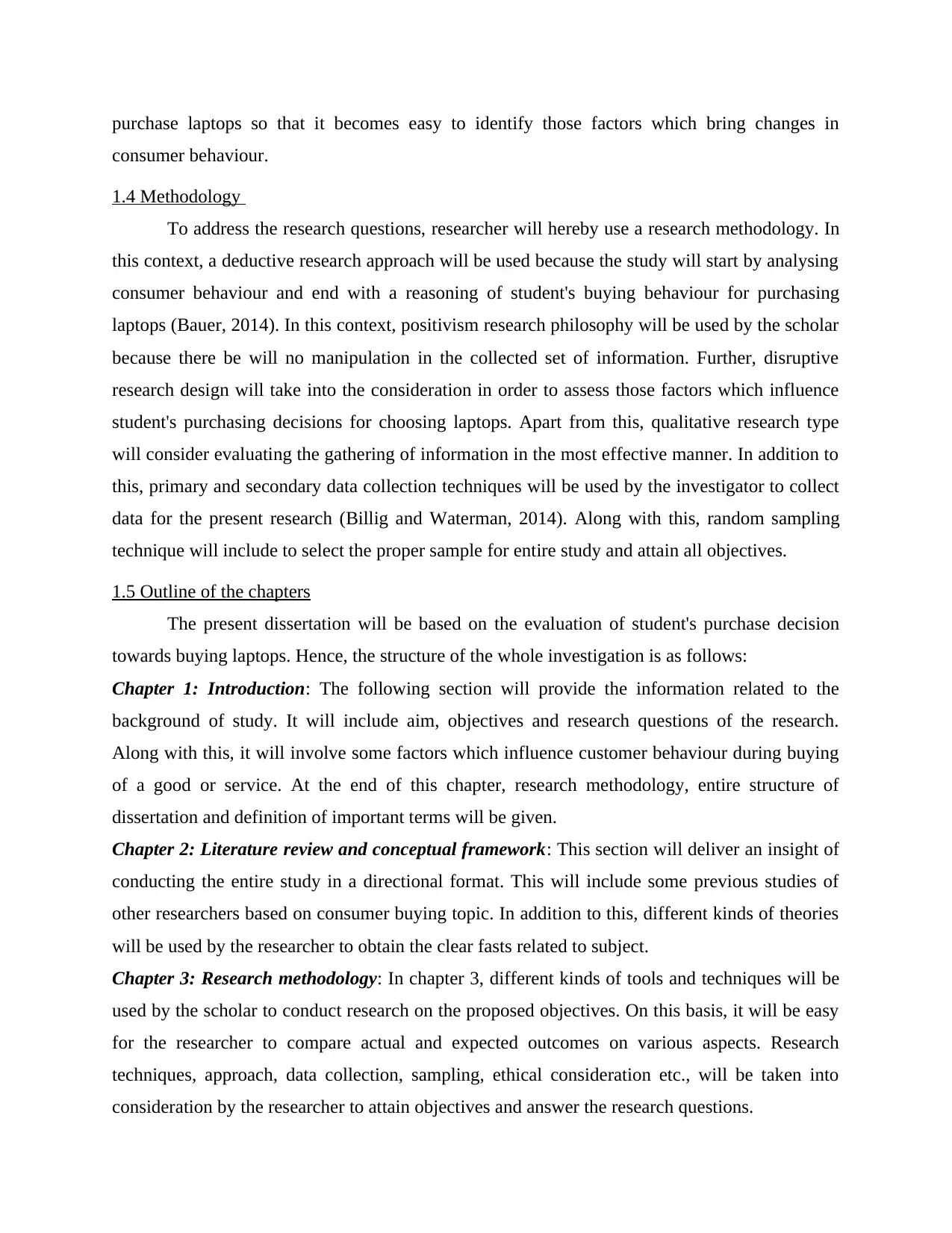
purchase laptops so that it becomes easy to identify those factors which bring changes in
consumer behaviour.
1.4 Methodology
To address the research questions, researcher will hereby use a research methodology. In
this context, a deductive research approach will be used because the study will start by analysing
consumer behaviour and end with a reasoning of student's buying behaviour for purchasing
laptops (Bauer, 2014). In this context, positivism research philosophy will be used by the scholar
because there be will no manipulation in the collected set of information. Further, disruptive
research design will take into the consideration in order to assess those factors which influence
student's purchasing decisions for choosing laptops. Apart from this, qualitative research type
will consider evaluating the gathering of information in the most effective manner. In addition to
this, primary and secondary data collection techniques will be used by the investigator to collect
data for the present research (Billig and Waterman, 2014). Along with this, random sampling
technique will include to select the proper sample for entire study and attain all objectives.
1.5 Outline of the chapters
The present dissertation will be based on the evaluation of student's purchase decision
towards buying laptops. Hence, the structure of the whole investigation is as follows:
Chapter 1: Introduction: The following section will provide the information related to the
background of study. It will include aim, objectives and research questions of the research.
Along with this, it will involve some factors which influence customer behaviour during buying
of a good or service. At the end of this chapter, research methodology, entire structure of
dissertation and definition of important terms will be given.
Chapter 2: Literature review and conceptual framework: This section will deliver an insight of
conducting the entire study in a directional format. This will include some previous studies of
other researchers based on consumer buying topic. In addition to this, different kinds of theories
will be used by the researcher to obtain the clear fasts related to subject.
Chapter 3: Research methodology: In chapter 3, different kinds of tools and techniques will be
used by the scholar to conduct research on the proposed objectives. On this basis, it will be easy
for the researcher to compare actual and expected outcomes on various aspects. Research
techniques, approach, data collection, sampling, ethical consideration etc., will be taken into
consideration by the researcher to attain objectives and answer the research questions.
consumer behaviour.
1.4 Methodology
To address the research questions, researcher will hereby use a research methodology. In
this context, a deductive research approach will be used because the study will start by analysing
consumer behaviour and end with a reasoning of student's buying behaviour for purchasing
laptops (Bauer, 2014). In this context, positivism research philosophy will be used by the scholar
because there be will no manipulation in the collected set of information. Further, disruptive
research design will take into the consideration in order to assess those factors which influence
student's purchasing decisions for choosing laptops. Apart from this, qualitative research type
will consider evaluating the gathering of information in the most effective manner. In addition to
this, primary and secondary data collection techniques will be used by the investigator to collect
data for the present research (Billig and Waterman, 2014). Along with this, random sampling
technique will include to select the proper sample for entire study and attain all objectives.
1.5 Outline of the chapters
The present dissertation will be based on the evaluation of student's purchase decision
towards buying laptops. Hence, the structure of the whole investigation is as follows:
Chapter 1: Introduction: The following section will provide the information related to the
background of study. It will include aim, objectives and research questions of the research.
Along with this, it will involve some factors which influence customer behaviour during buying
of a good or service. At the end of this chapter, research methodology, entire structure of
dissertation and definition of important terms will be given.
Chapter 2: Literature review and conceptual framework: This section will deliver an insight of
conducting the entire study in a directional format. This will include some previous studies of
other researchers based on consumer buying topic. In addition to this, different kinds of theories
will be used by the researcher to obtain the clear fasts related to subject.
Chapter 3: Research methodology: In chapter 3, different kinds of tools and techniques will be
used by the scholar to conduct research on the proposed objectives. On this basis, it will be easy
for the researcher to compare actual and expected outcomes on various aspects. Research
techniques, approach, data collection, sampling, ethical consideration etc., will be taken into
consideration by the researcher to attain objectives and answer the research questions.
Paraphrase This Document
Need a fresh take? Get an instant paraphrase of this document with our AI Paraphraser
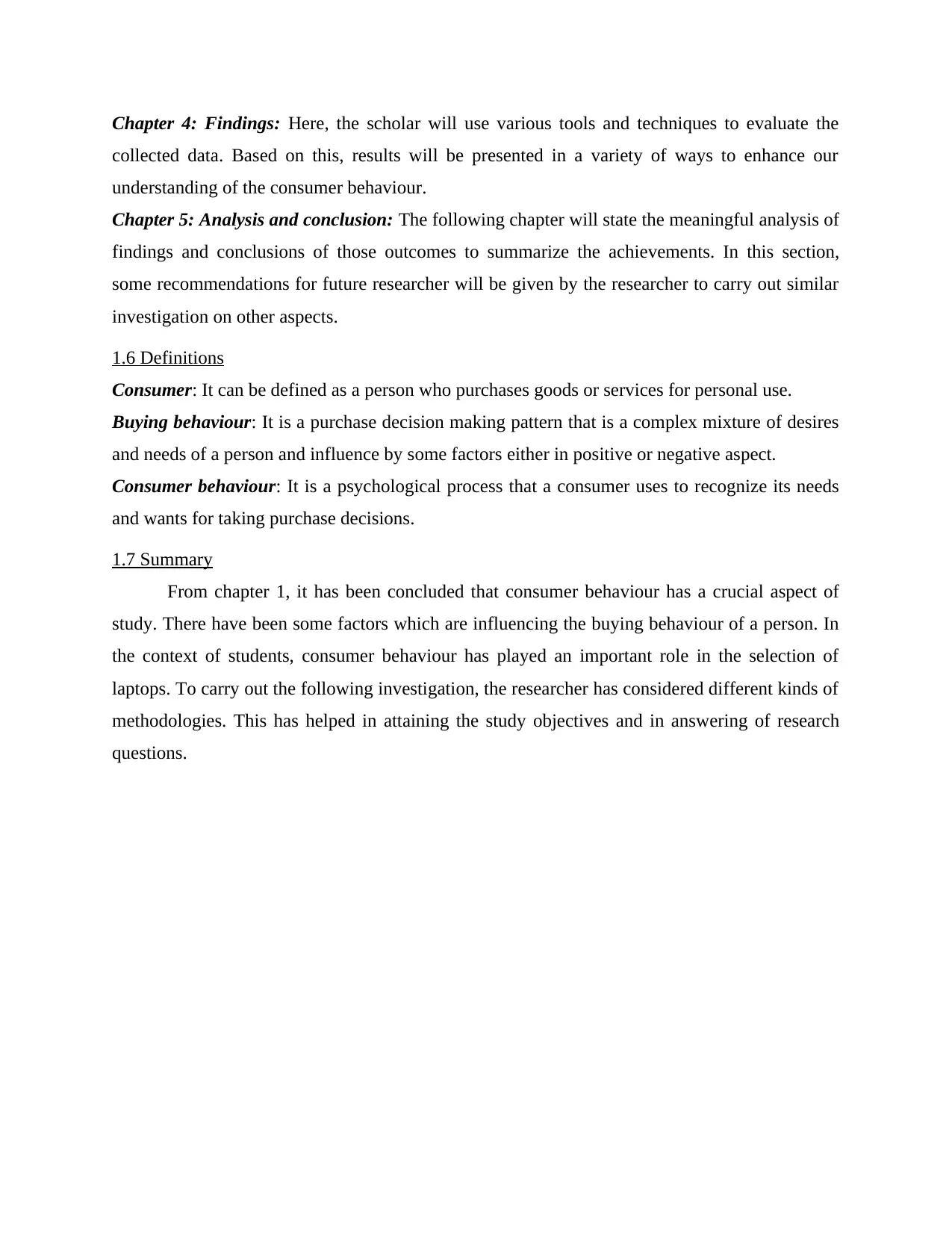
Chapter 4: Findings: Here, the scholar will use various tools and techniques to evaluate the
collected data. Based on this, results will be presented in a variety of ways to enhance our
understanding of the consumer behaviour.
Chapter 5: Analysis and conclusion: The following chapter will state the meaningful analysis of
findings and conclusions of those outcomes to summarize the achievements. In this section,
some recommendations for future researcher will be given by the researcher to carry out similar
investigation on other aspects.
1.6 Definitions
Consumer: It can be defined as a person who purchases goods or services for personal use.
Buying behaviour: It is a purchase decision making pattern that is a complex mixture of desires
and needs of a person and influence by some factors either in positive or negative aspect.
Consumer behaviour: It is a psychological process that a consumer uses to recognize its needs
and wants for taking purchase decisions.
1.7 Summary
From chapter 1, it has been concluded that consumer behaviour has a crucial aspect of
study. There have been some factors which are influencing the buying behaviour of a person. In
the context of students, consumer behaviour has played an important role in the selection of
laptops. To carry out the following investigation, the researcher has considered different kinds of
methodologies. This has helped in attaining the study objectives and in answering of research
questions.
collected data. Based on this, results will be presented in a variety of ways to enhance our
understanding of the consumer behaviour.
Chapter 5: Analysis and conclusion: The following chapter will state the meaningful analysis of
findings and conclusions of those outcomes to summarize the achievements. In this section,
some recommendations for future researcher will be given by the researcher to carry out similar
investigation on other aspects.
1.6 Definitions
Consumer: It can be defined as a person who purchases goods or services for personal use.
Buying behaviour: It is a purchase decision making pattern that is a complex mixture of desires
and needs of a person and influence by some factors either in positive or negative aspect.
Consumer behaviour: It is a psychological process that a consumer uses to recognize its needs
and wants for taking purchase decisions.
1.7 Summary
From chapter 1, it has been concluded that consumer behaviour has a crucial aspect of
study. There have been some factors which are influencing the buying behaviour of a person. In
the context of students, consumer behaviour has played an important role in the selection of
laptops. To carry out the following investigation, the researcher has considered different kinds of
methodologies. This has helped in attaining the study objectives and in answering of research
questions.
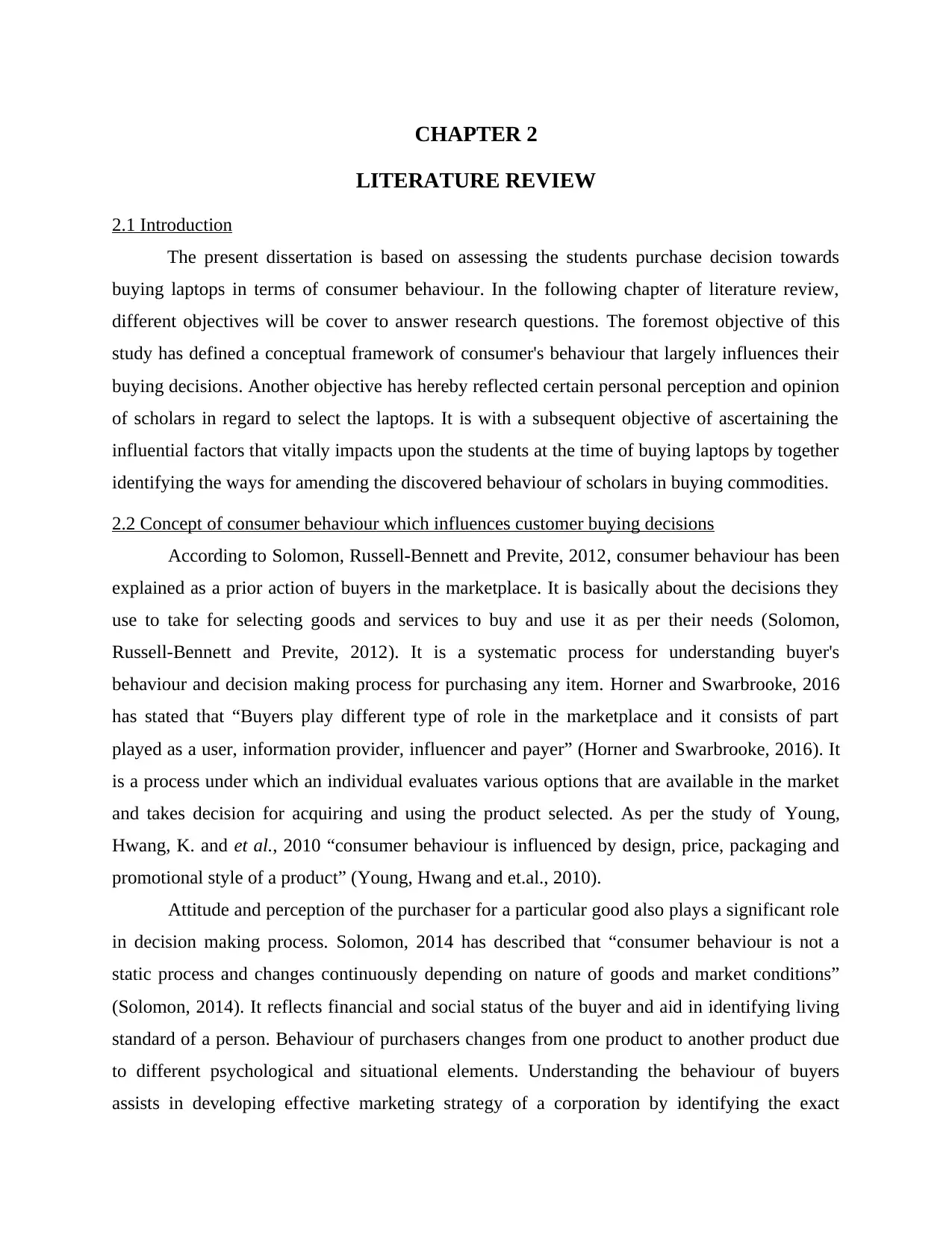
CHAPTER 2
LITERATURE REVIEW
2.1 Introduction
The present dissertation is based on assessing the students purchase decision towards
buying laptops in terms of consumer behaviour. In the following chapter of literature review,
different objectives will be cover to answer research questions. The foremost objective of this
study has defined a conceptual framework of consumer's behaviour that largely influences their
buying decisions. Another objective has hereby reflected certain personal perception and opinion
of scholars in regard to select the laptops. It is with a subsequent objective of ascertaining the
influential factors that vitally impacts upon the students at the time of buying laptops by together
identifying the ways for amending the discovered behaviour of scholars in buying commodities.
2.2 Concept of consumer behaviour which influences customer buying decisions
According to Solomon, Russell-Bennett and Previte, 2012, consumer behaviour has been
explained as a prior action of buyers in the marketplace. It is basically about the decisions they
use to take for selecting goods and services to buy and use it as per their needs (Solomon,
Russell-Bennett and Previte, 2012). It is a systematic process for understanding buyer's
behaviour and decision making process for purchasing any item. Horner and Swarbrooke, 2016
has stated that “Buyers play different type of role in the marketplace and it consists of part
played as a user, information provider, influencer and payer” (Horner and Swarbrooke, 2016). It
is a process under which an individual evaluates various options that are available in the market
and takes decision for acquiring and using the product selected. As per the study of Young,
Hwang, K. and et al., 2010 “consumer behaviour is influenced by design, price, packaging and
promotional style of a product” (Young, Hwang and et.al., 2010).
Attitude and perception of the purchaser for a particular good also plays a significant role
in decision making process. Solomon, 2014 has described that “consumer behaviour is not a
static process and changes continuously depending on nature of goods and market conditions”
(Solomon, 2014). It reflects financial and social status of the buyer and aid in identifying living
standard of a person. Behaviour of purchasers changes from one product to another product due
to different psychological and situational elements. Understanding the behaviour of buyers
assists in developing effective marketing strategy of a corporation by identifying the exact
LITERATURE REVIEW
2.1 Introduction
The present dissertation is based on assessing the students purchase decision towards
buying laptops in terms of consumer behaviour. In the following chapter of literature review,
different objectives will be cover to answer research questions. The foremost objective of this
study has defined a conceptual framework of consumer's behaviour that largely influences their
buying decisions. Another objective has hereby reflected certain personal perception and opinion
of scholars in regard to select the laptops. It is with a subsequent objective of ascertaining the
influential factors that vitally impacts upon the students at the time of buying laptops by together
identifying the ways for amending the discovered behaviour of scholars in buying commodities.
2.2 Concept of consumer behaviour which influences customer buying decisions
According to Solomon, Russell-Bennett and Previte, 2012, consumer behaviour has been
explained as a prior action of buyers in the marketplace. It is basically about the decisions they
use to take for selecting goods and services to buy and use it as per their needs (Solomon,
Russell-Bennett and Previte, 2012). It is a systematic process for understanding buyer's
behaviour and decision making process for purchasing any item. Horner and Swarbrooke, 2016
has stated that “Buyers play different type of role in the marketplace and it consists of part
played as a user, information provider, influencer and payer” (Horner and Swarbrooke, 2016). It
is a process under which an individual evaluates various options that are available in the market
and takes decision for acquiring and using the product selected. As per the study of Young,
Hwang, K. and et al., 2010 “consumer behaviour is influenced by design, price, packaging and
promotional style of a product” (Young, Hwang and et.al., 2010).
Attitude and perception of the purchaser for a particular good also plays a significant role
in decision making process. Solomon, 2014 has described that “consumer behaviour is not a
static process and changes continuously depending on nature of goods and market conditions”
(Solomon, 2014). It reflects financial and social status of the buyer and aid in identifying living
standard of a person. Behaviour of purchasers changes from one product to another product due
to different psychological and situational elements. Understanding the behaviour of buyers
assists in developing effective marketing strategy of a corporation by identifying the exact
⊘ This is a preview!⊘
Do you want full access?
Subscribe today to unlock all pages.

Trusted by 1+ million students worldwide

requirements of their purchasers. In this context, Schiffman, O'Cass, Paladino and Carlson, 2013
have explained that “Behaviour of customers changes across regions and countries” (Schiffman,
O'Cass, Paladino and Carlson, 2013).
People living in different geographical environment show contrasting behaviour for
purchasing any manufactured item. It also depends upon lifestyle, culture and upbringing of an
individual which influence final decision making process. It is beneficial for the companies to
understand consumer behaviour for designing and planning their overall business operations.
According to Akehurst, Afonso and Martins Gonçalves (2012) “Marketers can study consumer
behaviour for positioning and selling their products to a specific group or a targeted set of
individuals” (Akehurst, Afonso and Martins Gonçalves, 2012). Focused marketing strategies can
be designed by marketers with understanding methods of customer purchasing and after
purchasing reaction of buyer. Understanding customer's reaction assist a firm in making effective
utilization of its physical, human and financial resources in a planned and organized way.
Consumers differs on the basis of culture, preference, sex, age, education level and financial
conditions (Miller, 2013).
While studying the customer behaviour it is important that this entire component should
be considered for carrying out the study. Enterprise can identify various needs and requirement
of the purchaser and can develop its product design. Packaging and promotional strategies are
according to that requirement of the end users. In the support of above statement, Gunter and
Furnham (2014) has explained that “Different contextual elements including marketing
strategies, technological and economical changes affect the overall judgement of purchaser for
buying a good” (Gunter and Furnham, 2014). Buyer's current and future expectation can largely
influence their buying preferences in order to purchase a product. This can be identified by an
appropriate development of promotional strategy in order to address their distinct sort of desires.
2.3 Personal perception and opinion of students regarding selection of laptops
According to Solomon, Russell-Bennett and Previte, 2012, “the success of a business
entirely depends upon its ability to attract and retain the potent number of customers for the
longer period of time” (Solomon, Russell-Bennett and Previte, 2012). Consumer perception
hereby depicts a comparison between how an average customer and a potential purchaser views
the products and services of a company. Such referral is important for an organization as it may
influence the buyer's behaviour either in positive or negative manner. On the basis of customer's
have explained that “Behaviour of customers changes across regions and countries” (Schiffman,
O'Cass, Paladino and Carlson, 2013).
People living in different geographical environment show contrasting behaviour for
purchasing any manufactured item. It also depends upon lifestyle, culture and upbringing of an
individual which influence final decision making process. It is beneficial for the companies to
understand consumer behaviour for designing and planning their overall business operations.
According to Akehurst, Afonso and Martins Gonçalves (2012) “Marketers can study consumer
behaviour for positioning and selling their products to a specific group or a targeted set of
individuals” (Akehurst, Afonso and Martins Gonçalves, 2012). Focused marketing strategies can
be designed by marketers with understanding methods of customer purchasing and after
purchasing reaction of buyer. Understanding customer's reaction assist a firm in making effective
utilization of its physical, human and financial resources in a planned and organized way.
Consumers differs on the basis of culture, preference, sex, age, education level and financial
conditions (Miller, 2013).
While studying the customer behaviour it is important that this entire component should
be considered for carrying out the study. Enterprise can identify various needs and requirement
of the purchaser and can develop its product design. Packaging and promotional strategies are
according to that requirement of the end users. In the support of above statement, Gunter and
Furnham (2014) has explained that “Different contextual elements including marketing
strategies, technological and economical changes affect the overall judgement of purchaser for
buying a good” (Gunter and Furnham, 2014). Buyer's current and future expectation can largely
influence their buying preferences in order to purchase a product. This can be identified by an
appropriate development of promotional strategy in order to address their distinct sort of desires.
2.3 Personal perception and opinion of students regarding selection of laptops
According to Solomon, Russell-Bennett and Previte, 2012, “the success of a business
entirely depends upon its ability to attract and retain the potent number of customers for the
longer period of time” (Solomon, Russell-Bennett and Previte, 2012). Consumer perception
hereby depicts a comparison between how an average customer and a potential purchaser views
the products and services of a company. Such referral is important for an organization as it may
influence the buyer's behaviour either in positive or negative manner. On the basis of customer's
Paraphrase This Document
Need a fresh take? Get an instant paraphrase of this document with our AI Paraphraser
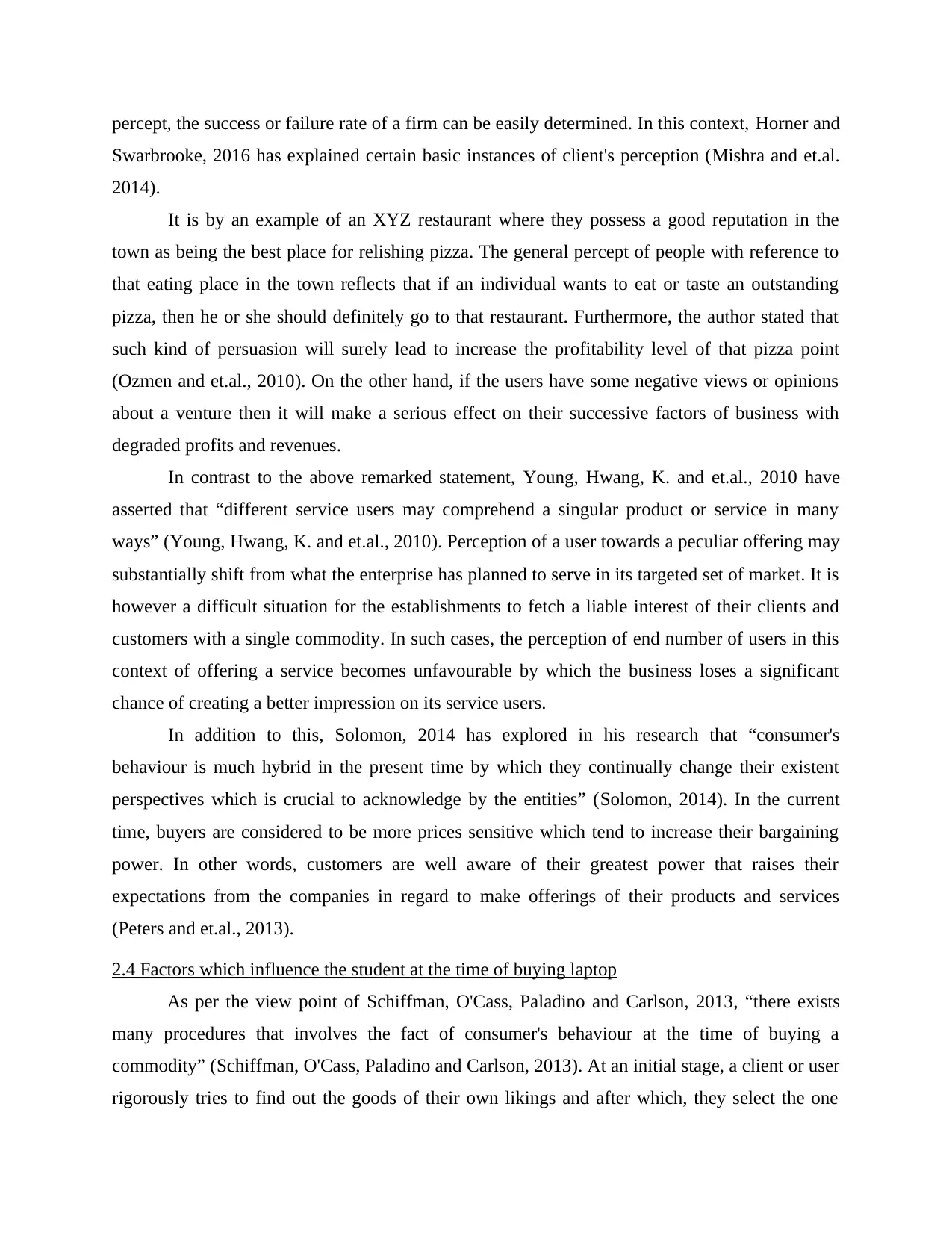
percept, the success or failure rate of a firm can be easily determined. In this context, Horner and
Swarbrooke, 2016 has explained certain basic instances of client's perception (Mishra and et.al.
2014).
It is by an example of an XYZ restaurant where they possess a good reputation in the
town as being the best place for relishing pizza. The general percept of people with reference to
that eating place in the town reflects that if an individual wants to eat or taste an outstanding
pizza, then he or she should definitely go to that restaurant. Furthermore, the author stated that
such kind of persuasion will surely lead to increase the profitability level of that pizza point
(Ozmen and et.al., 2010). On the other hand, if the users have some negative views or opinions
about a venture then it will make a serious effect on their successive factors of business with
degraded profits and revenues.
In contrast to the above remarked statement, Young, Hwang, K. and et.al., 2010 have
asserted that “different service users may comprehend a singular product or service in many
ways” (Young, Hwang, K. and et.al., 2010). Perception of a user towards a peculiar offering may
substantially shift from what the enterprise has planned to serve in its targeted set of market. It is
however a difficult situation for the establishments to fetch a liable interest of their clients and
customers with a single commodity. In such cases, the perception of end number of users in this
context of offering a service becomes unfavourable by which the business loses a significant
chance of creating a better impression on its service users.
In addition to this, Solomon, 2014 has explored in his research that “consumer's
behaviour is much hybrid in the present time by which they continually change their existent
perspectives which is crucial to acknowledge by the entities” (Solomon, 2014). In the current
time, buyers are considered to be more prices sensitive which tend to increase their bargaining
power. In other words, customers are well aware of their greatest power that raises their
expectations from the companies in regard to make offerings of their products and services
(Peters and et.al., 2013).
2.4 Factors which influence the student at the time of buying laptop
As per the view point of Schiffman, O'Cass, Paladino and Carlson, 2013, “there exists
many procedures that involves the fact of consumer's behaviour at the time of buying a
commodity” (Schiffman, O'Cass, Paladino and Carlson, 2013). At an initial stage, a client or user
rigorously tries to find out the goods of their own likings and after which, they select the one
Swarbrooke, 2016 has explained certain basic instances of client's perception (Mishra and et.al.
2014).
It is by an example of an XYZ restaurant where they possess a good reputation in the
town as being the best place for relishing pizza. The general percept of people with reference to
that eating place in the town reflects that if an individual wants to eat or taste an outstanding
pizza, then he or she should definitely go to that restaurant. Furthermore, the author stated that
such kind of persuasion will surely lead to increase the profitability level of that pizza point
(Ozmen and et.al., 2010). On the other hand, if the users have some negative views or opinions
about a venture then it will make a serious effect on their successive factors of business with
degraded profits and revenues.
In contrast to the above remarked statement, Young, Hwang, K. and et.al., 2010 have
asserted that “different service users may comprehend a singular product or service in many
ways” (Young, Hwang, K. and et.al., 2010). Perception of a user towards a peculiar offering may
substantially shift from what the enterprise has planned to serve in its targeted set of market. It is
however a difficult situation for the establishments to fetch a liable interest of their clients and
customers with a single commodity. In such cases, the perception of end number of users in this
context of offering a service becomes unfavourable by which the business loses a significant
chance of creating a better impression on its service users.
In addition to this, Solomon, 2014 has explored in his research that “consumer's
behaviour is much hybrid in the present time by which they continually change their existent
perspectives which is crucial to acknowledge by the entities” (Solomon, 2014). In the current
time, buyers are considered to be more prices sensitive which tend to increase their bargaining
power. In other words, customers are well aware of their greatest power that raises their
expectations from the companies in regard to make offerings of their products and services
(Peters and et.al., 2013).
2.4 Factors which influence the student at the time of buying laptop
As per the view point of Schiffman, O'Cass, Paladino and Carlson, 2013, “there exists
many procedures that involves the fact of consumer's behaviour at the time of buying a
commodity” (Schiffman, O'Cass, Paladino and Carlson, 2013). At an initial stage, a client or user
rigorously tries to find out the goods of their own likings and after which, they select the one
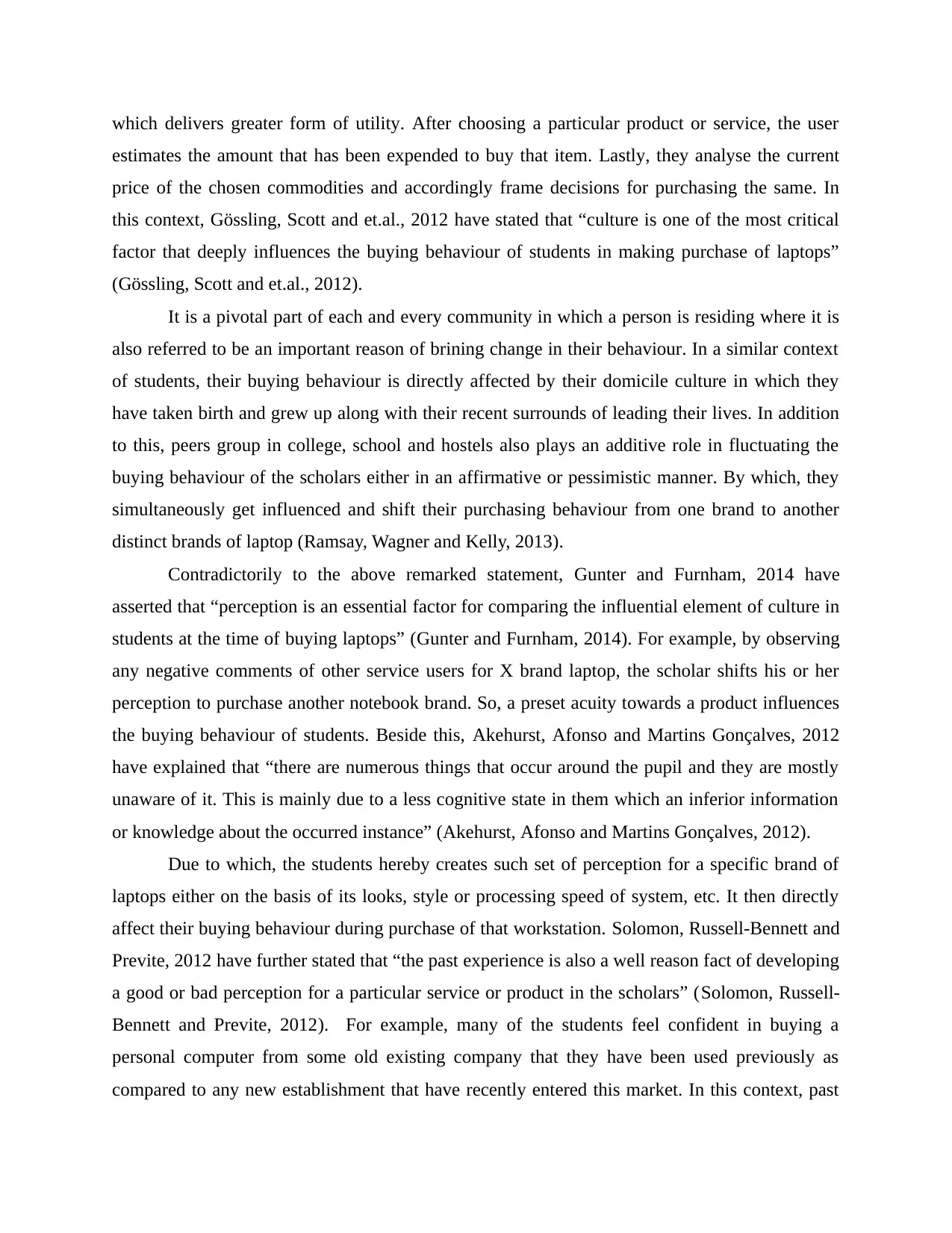
which delivers greater form of utility. After choosing a particular product or service, the user
estimates the amount that has been expended to buy that item. Lastly, they analyse the current
price of the chosen commodities and accordingly frame decisions for purchasing the same. In
this context, Gössling, Scott and et.al., 2012 have stated that “culture is one of the most critical
factor that deeply influences the buying behaviour of students in making purchase of laptops”
(Gössling, Scott and et.al., 2012).
It is a pivotal part of each and every community in which a person is residing where it is
also referred to be an important reason of brining change in their behaviour. In a similar context
of students, their buying behaviour is directly affected by their domicile culture in which they
have taken birth and grew up along with their recent surrounds of leading their lives. In addition
to this, peers group in college, school and hostels also plays an additive role in fluctuating the
buying behaviour of the scholars either in an affirmative or pessimistic manner. By which, they
simultaneously get influenced and shift their purchasing behaviour from one brand to another
distinct brands of laptop (Ramsay, Wagner and Kelly, 2013).
Contradictorily to the above remarked statement, Gunter and Furnham, 2014 have
asserted that “perception is an essential factor for comparing the influential element of culture in
students at the time of buying laptops” (Gunter and Furnham, 2014). For example, by observing
any negative comments of other service users for X brand laptop, the scholar shifts his or her
perception to purchase another notebook brand. So, a preset acuity towards a product influences
the buying behaviour of students. Beside this, Akehurst, Afonso and Martins Gonçalves, 2012
have explained that “there are numerous things that occur around the pupil and they are mostly
unaware of it. This is mainly due to a less cognitive state in them which an inferior information
or knowledge about the occurred instance” (Akehurst, Afonso and Martins Gonçalves, 2012).
Due to which, the students hereby creates such set of perception for a specific brand of
laptops either on the basis of its looks, style or processing speed of system, etc. It then directly
affect their buying behaviour during purchase of that workstation. Solomon, Russell-Bennett and
Previte, 2012 have further stated that “the past experience is also a well reason fact of developing
a good or bad perception for a particular service or product in the scholars” (Solomon, Russell-
Bennett and Previte, 2012). For example, many of the students feel confident in buying a
personal computer from some old existing company that they have been used previously as
compared to any new establishment that have recently entered this market. In this context, past
estimates the amount that has been expended to buy that item. Lastly, they analyse the current
price of the chosen commodities and accordingly frame decisions for purchasing the same. In
this context, Gössling, Scott and et.al., 2012 have stated that “culture is one of the most critical
factor that deeply influences the buying behaviour of students in making purchase of laptops”
(Gössling, Scott and et.al., 2012).
It is a pivotal part of each and every community in which a person is residing where it is
also referred to be an important reason of brining change in their behaviour. In a similar context
of students, their buying behaviour is directly affected by their domicile culture in which they
have taken birth and grew up along with their recent surrounds of leading their lives. In addition
to this, peers group in college, school and hostels also plays an additive role in fluctuating the
buying behaviour of the scholars either in an affirmative or pessimistic manner. By which, they
simultaneously get influenced and shift their purchasing behaviour from one brand to another
distinct brands of laptop (Ramsay, Wagner and Kelly, 2013).
Contradictorily to the above remarked statement, Gunter and Furnham, 2014 have
asserted that “perception is an essential factor for comparing the influential element of culture in
students at the time of buying laptops” (Gunter and Furnham, 2014). For example, by observing
any negative comments of other service users for X brand laptop, the scholar shifts his or her
perception to purchase another notebook brand. So, a preset acuity towards a product influences
the buying behaviour of students. Beside this, Akehurst, Afonso and Martins Gonçalves, 2012
have explained that “there are numerous things that occur around the pupil and they are mostly
unaware of it. This is mainly due to a less cognitive state in them which an inferior information
or knowledge about the occurred instance” (Akehurst, Afonso and Martins Gonçalves, 2012).
Due to which, the students hereby creates such set of perception for a specific brand of
laptops either on the basis of its looks, style or processing speed of system, etc. It then directly
affect their buying behaviour during purchase of that workstation. Solomon, Russell-Bennett and
Previte, 2012 have further stated that “the past experience is also a well reason fact of developing
a good or bad perception for a particular service or product in the scholars” (Solomon, Russell-
Bennett and Previte, 2012). For example, many of the students feel confident in buying a
personal computer from some old existing company that they have been used previously as
compared to any new establishment that have recently entered this market. In this context, past
⊘ This is a preview!⊘
Do you want full access?
Subscribe today to unlock all pages.

Trusted by 1+ million students worldwide
1 out of 64
Related Documents
Your All-in-One AI-Powered Toolkit for Academic Success.
+13062052269
info@desklib.com
Available 24*7 on WhatsApp / Email
![[object Object]](/_next/static/media/star-bottom.7253800d.svg)
Unlock your academic potential
Copyright © 2020–2025 A2Z Services. All Rights Reserved. Developed and managed by ZUCOL.





